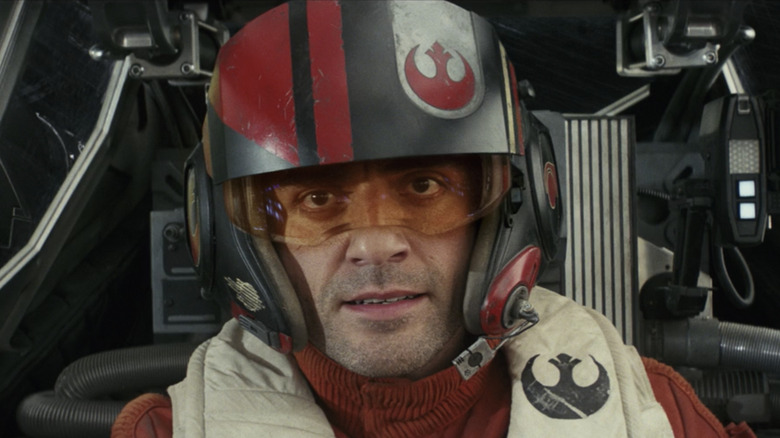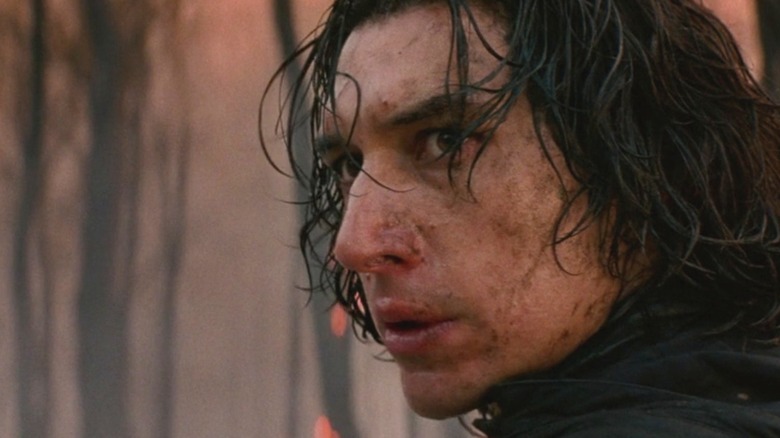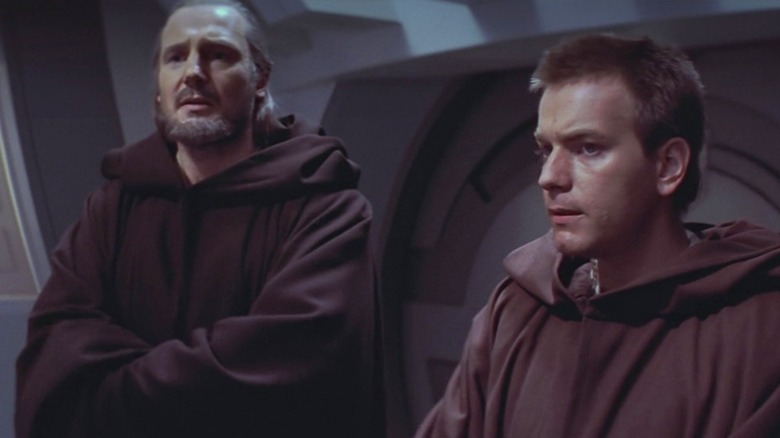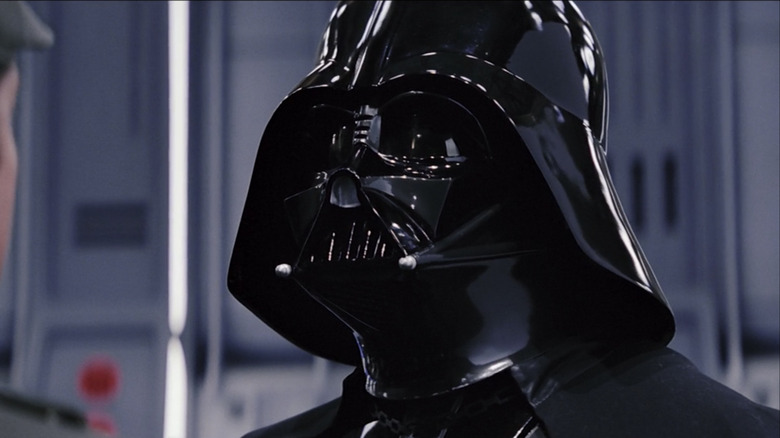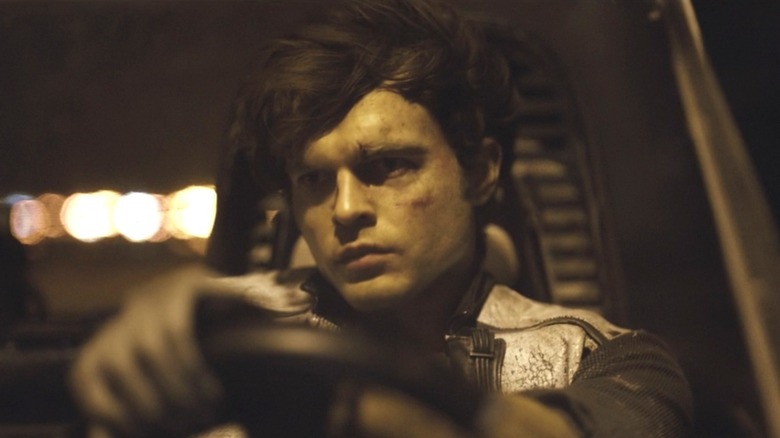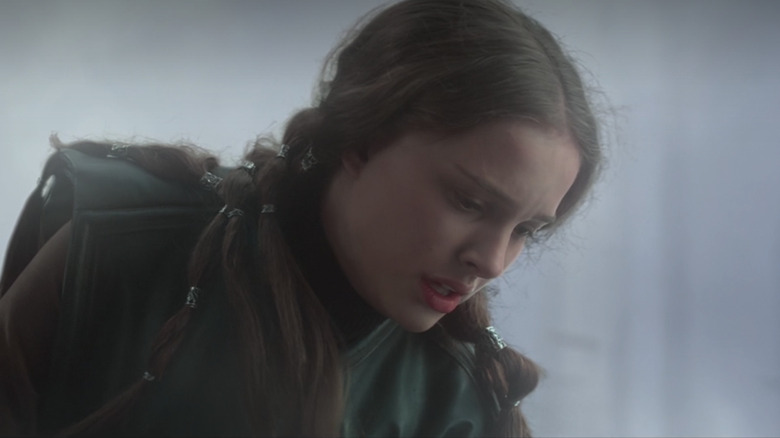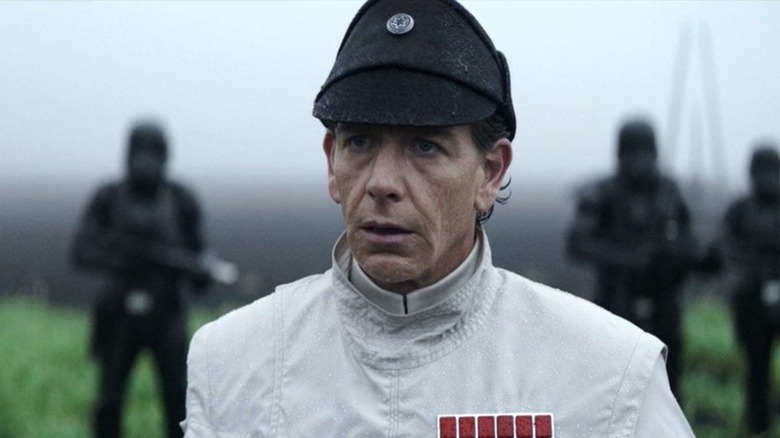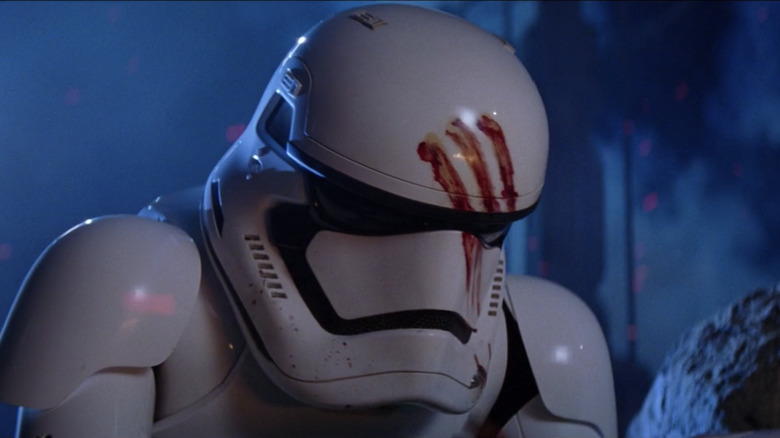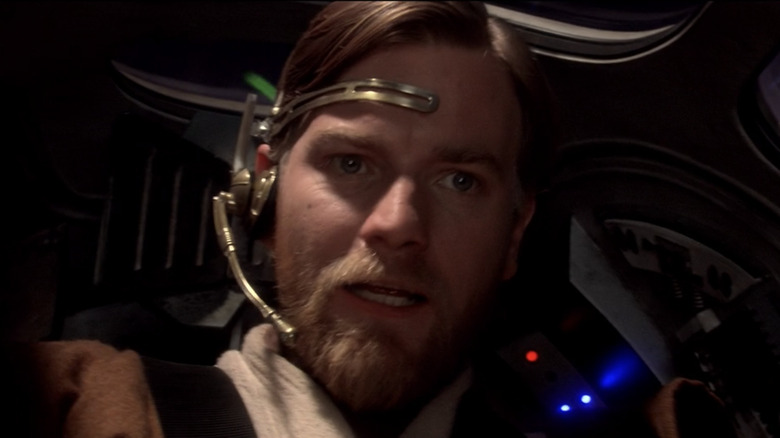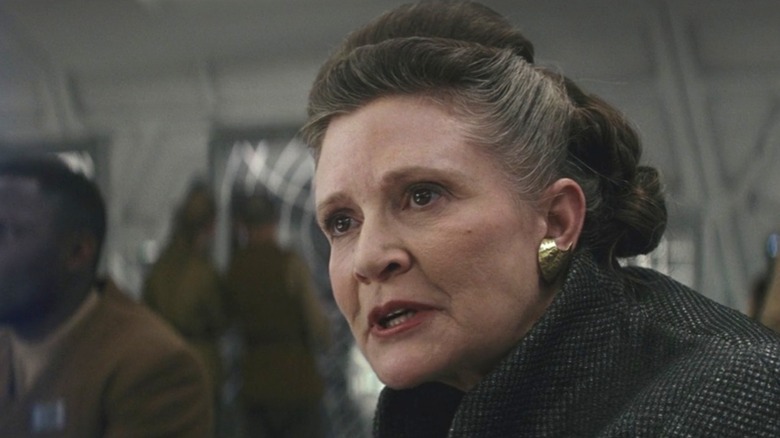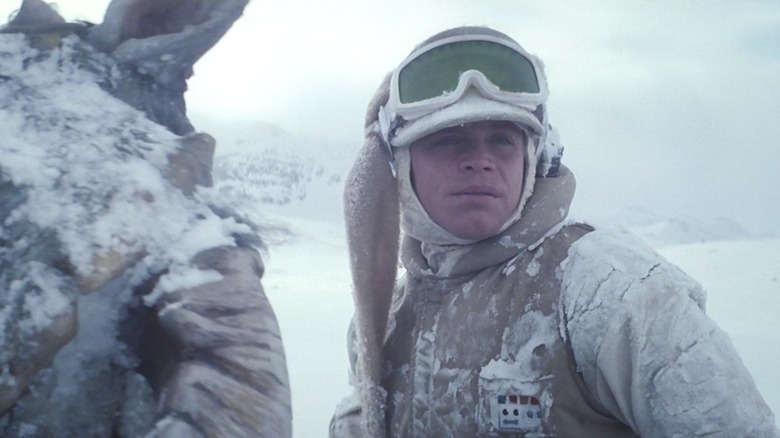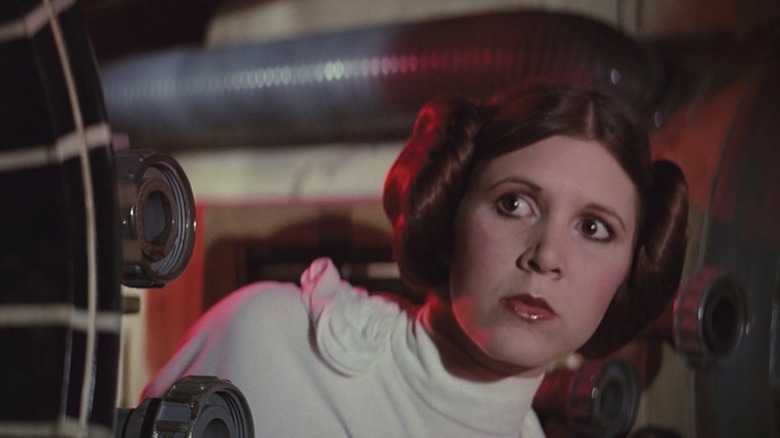Every Star Wars Movie's Opening Scene Ranked
Hot, buttered popcorn in a cool, dark movie theater. The drum-and-horn march of Alfred Newman's "20th Century Fox Fanfare." Silence as blue letters flash across a black screen: "A long time ago in a galaxy far, far away...." And then, the unmistakable blare of John Williams' iconic score; on screen, a block of yellow text slowly flying upward towards the heavens. A "Star Wars" movie has begun.
For 45 years, each "Star Wars" film has begun more or less this same way. There have been a few changes, naturally; the Disney-produced sequels, starting with 2015's "The Force Awakens," no longer use the Fox fanfare, and the non-"Episode" prequels "Rogue One" and "Solo" had their own variations on the opening theme song and title crawl. But every one of them follows up the serial-like preamble with a whiz-bang opening scene that sets the tone for the movie that will follow. Some of these opening scenes are all-time classics, some are underappreciated gems, and some, frankly, promise a better time than the rest of the film can deliver. Let's take a look at the opening scenes of every "Star Wars" movie, ranked from worst to best.
11. Episode IX - The Rise of Skywalker
None of these scenes are outright terrible, but one has to come in last, and unfortunately that honor goes to the most recent film, "Episode IX – The Rise of Skywalker." The most poorly-reviewed of the sequel trilogy (and among the most poorly-reviewed of the franchise as a whole), the opening sequence begins promisingly enough, foregrounding the almost-too-good intensity of star Adam Driver as would-be Sith lord Kylo Ren plows through a group of enemy combatants on the trail of the newly resurrected Emperor Palpatine (Ian McDiarmid).
From there, however, things quickly fall apart as the sequence reveals the film's true intentions. Ren's goal in this slaughter is to find a tracking device which will take him to the stormy planet Exegol, foreshadowing the rest of the film's interminable fetch quest plot structure. More importantly, though, the sequence walks back not only the most important plot, character, and even design developments of the previous film, Rian Johnson's "The Last Jedi," but even director J.J. Abrams' own sequel trilogy kickstarter "The Force Awakens."
10. Episode I - The Phantom Menace
In the 16 years between 1983's "Return of the Jedi" and 1999's "Episode I – The Phantom Menace," anticipation among fans had grown to a fever pitch. What would "Star Wars" look like in the modern era, with a new cast and state-of-the-art effects? The answer, apparently, was political bureaucracy, as the opening scene of "The Phantom Menace" thrusts Jedi Knight Qui-Gon Jinn (Liam Neeson) and his young apprentice Obi-Wan Kenobi (Ewan McGregor) into a taxation conflict between the Trade Federation and the Galactic Senate, with the small planet of Naboo caught in the middle.
The sequence is not all dry negotiations, of course. The spineless Trade Federation, under the command of a mysterious cloaked figure, sends droid soldiers to kill Qui-Gon and Obi-Wan, and a "Star Wars"-style blaster-and-lightsaber battle ensues. But many of Lucas' most questionable choices in the film, and indeed the prequel trilogy as a whole, are already present: the flat direction and stilted dialogue that defeats normally charismatic actors like Neeson, McGregor, and Natalie Portman; the decision to model several alien species after specific ethnic caricatures; the preference over lightweight, frictionless CGI over the more tactile, familiar textures of models and makeup. Every "Star Wars" opening scene work bests as a preview of the style and thematic concerns that the rest of the film will follow, and "Phantom Menace," for better or worse, is exactly that.
9. Episode VI - Return of the Jedi
Years before George Lucas began to meddle with "Star Wars" via the CGI-enhanced special editions and tweaks to various home video releases, there was "Episode VI – Return of the Jedi," a film whose structure bears more than a little resemblance to the first "Star Wars" (which was subtitled "A New Hope" in 1979). As in the original film, "Jedi" spends much of its first act on the desert planet Tatooine and climaxes with the Rebels' victory over the Empire's newly constructed Death Star. One gets the sense that Lucas wanted a do-over on certain parts of "A New Hope," taking advantage of the technological and budgetary leaps made since 1977 to re-do the rubber-masked Mos Eisley cantina scene as the wild animatronic menagerie of Jabba the Hutt's palace and stage a bigger, busier Death Star battle than was possible the first time around.
"Jedi's" opening scene establishes an under-construction Death Star, looking more like a face with an open mouth than the original's small moon shape, and also establishes that Darth Vader (David Prowse and James Earl Jones) is back to playing second banana as he did to Peter Cushing in "A New Hope," with Vader announcing to the Death Star's commander that the Emperor will be coming to oversee the completion of the base. It's an ominous scene that matches the darker tone of "The Empire Strikes Back" but doesn't jibe with most of the creature feature, Ewok-filled adventure that follows.
8. Solo: A Star Wars Story
For a franchise that once went 16 years between films, "Star Wars" was risking serious audience fatigue when it released "Solo: A Star Wars Story" just six months after "The Last Jedi." Not only that, but the production went through a high-profile shakeup when original directors Phil Lord and Chris Miller were fired and replaced by filmmaker Ron Howard, resulting in massive reshoots. Not only that, but the film was attempting to recast Harrison Ford's Han Solo, one of the most iconic pairings of actor and character in film history. The odds were stacked against "Solo" working at all, but you know how this guy feels about telling him the odds.
The resulting film is torn between delivering a fun space adventure and hitting every recognizable part of Han Solo's backstory, from important moments like meeting his Wookiee co-pilot Chewbacca and winning the Millennium Falcon from frenemy Lando Calrissian (Donald Glover) to trivial ones like how he got his gun. The opening scene serves up this conflict in miniature — Howard directs a fleet, fun speeder chase through the broken down shipyards of young Han's (Alden Ehrenreich) home planet, set to a rousing and romantic new theme from composer John Williams, all bogged down by references to thermal detonators, the gold dice that will one day hang in the Falcon's cockpit, and the laughably unnecessary moment in which Han's clearly symbolic last name is literally bestowed upon him.
7. Episode II - Attack of the Clones
"Episode II – Attack of the Clones" starts with a bang — literally — as an explosion rocks queen-turned-senator Padmé Amidala's (Natalie Portman) ship as it lands on the Republic capitol planet Coruscant, killing the handmaiden serving as her decoy (which she still apparently has, despite no longer being queen). The identity of the bomber and their reasons for wanting Padmé dead are treated as an important mystery, with Obi-Wan Kenobi (a mulleted Ewan McGregor) playing detective while his apprentice Anakin Skywalker (Hayden Christensen) violates his Jedi oath by falling in love with Padmé while serving as her bodyguard.
Intrigue is not a color that "Star Wars" paints with very often, and it's particularly difficult with prequels — audiences know from the start that the ultimate culprit is newly-elected Supreme Chancellor Palpatine, who will use a phony war to consolidate power on the way to becoming Emperor and destroying the Jedi. Still, "Attack of the Clones" gives it the old college try, leaning into a 1940s detective vibe as Padmé's chrome art-deco-inspired ship glides through the Coruscant clouds in the opening scene, sounding like an old propeller plane. But while it's fun to imagine a full-on film noir "Star Wars," the movie ultimately isn't interested in sustaining that vibe, and "Attack of the Clones" soon returns to the more-is-more aesthetic that marks the prequel trilogy as a whole.
6. Rogue One: A Star Wars Story
The second "Star Wars" film produced by Disney, 2016's bleak prequel "Rogue One: A Star Wars Story" was beset by reshoots and behind-the-scenes shake ups just as "Solo" would be two years later. For audiences, that mostly translated to a number of scenes from the film's trailer not showing up in the final cut; the finished film hangs together remarkably well, a stark consideration of wartime sacrifice that affords no last-minute rescue for its doomed Rebel spies.
That tone is set in the film's opening scene, a flashback in which the pastoral life of young Jyn Erso (Beau Gadsdon in this scene, Felicity Jones as an adult) and her family is shattered by the arrival of Imperial troops. Her father Galen (Mads Mikkelsen) was an Imperial scientist whose moral objections to working on the Death Star forced him into hiding, but now the Empire, represented by the slimy Orson Krennic (Ben Mendelsohn at his most villainously charismatic), has come calling once again. Young Jyn flees to an underground bunker as her mother Lyra (Valene Kane) is shot down by Stormtroopers and Galen is taken away to finish his work on the deadly space station. The scene effectively lays out the narrative and emotional stakes of the rest of the film, even if it's also a prime example of the Disney prequel tendency to have everything important to a character happen all at once.
5. Episode VII - The Force Awakens
"Luke Skywalker has vanished." After a prequel trilogy's worth of Trade Federations, separatists, Counts Dooku and Generals Grievous, J.J. Abrams' 2015 sequel "Episode VII – The Force Awakens" announces its back-to-basics intentions in the first line of the title crawl. Here, the original trilogy's characters are not just beloved and legendary to audiences, but to the series' new characters as well; when ace X-Wing pilot Poe Dameron (Oscar Isaac) refers to Leia by her newly established rank of General, an old Rebel ally (screen legend Max von Sydow) smiles warmly and replies, "To me, she's royalty."
The opening scene nominally concerns the battle for a star map that will reveal Luke's whereabouts, but structurally serves to introduce most of the sequel trilogy's new characters: Poe, seemingly beamed in from an alternate universe in which Al Pacino had played Han Solo; cosplaying dark lord Kylo Ren, who attacks von Sydow's desert village in search of the star map and uses his Dark Side powers to freeze a laser blast in mid-air; conflicted stormtrooper Finn (John Boyega), whose first taste of combat leaves him traumatized and looking for a way out; and BB-8, a next-gen R2-D2 with more charisma and personality than many of the prequel trilogy's human performers. Only Daisy Ridley's Rey is missing from the sequence — just like Luke in "A New Hope," she won't show up for another few scenes.
4. Episode III - Revenge of the Sith
After two films of throat-clearing, 2005's "Episode III – Revenge of the Sith" finally lands viewers in the middle of an actual star war, as Obi-Wan Kenobi and Anakin Skywalker race to "rescue" Chancellor Palpatine from the clutches of Sith lord Count Dooku (horror icon Christopher Lee) and the four-armed Jedi-killing droid General Grievous. Little do they know, of course, that Palpatine is in fact Dooku's evil master, and that the kidnapping was staged as part of his years-long plan to rule the galaxy.
"Star Wars" rarely takes full advantage of the three-dimensionality of outer space, which makes it a pleasant surprise when the camera pans down from Obi-Wan and Anakin's solitary interceptors to settle on the gigantic battle raging just below them. The three years since "Attack of the Clones" have seen a noticeable jump in the quality of the film's effects, as well as in Ewan McGregor's hair, now a respectable, Alec Guinness-like side part. He gets the series catchphrase "I have a bad feeling about this" while Hayden Christensen gets to join Harrison Ford in telling us where the fun begins. Christensen still struggles with infusing Anakin with anything resembling charm or passion, but overall the film is invigorated by being the final entry in the prequel trilogy, at last able to show all the things audiences have been waiting for, from the fall of the Republic and the rise of Darth Vader to Yoda and Chewbacca being friends, apparently.
3. Episode VIII - The Last Jedi
"Star Wars" has had its share of humor, often powered by the charisma of its actors, but it rarely tries to tell jokes (Jar Jar Binks notwithstanding). And among the types of jokes that a "Star Wars" film would try to tell, a prank phone call would certainly be one of the more unexpected. But that's exactly what happens at the start of Rian Johnson's "Episode VIII – The Last Jedi," as Poe Dameron stalls for time while his rocket-boosted X-Wing powers up by hailing First Order general Hux (Domhnall Gleeson) and then pretending not to able to hear him. As Hux blusters about in confusion, one of his captains has to explain the joke: "I believe he's tooling with you, sir."
But Johnson has more on his mind than making "Star Wars" intentionally funny again, as seen in the rest of the opening scene — a cracker-jack battle sequence that culminates in a disastrous bombing raid, the first of many defeats for the Resistance over the course of the film. Like "Rogue One," "The Last Jedi" is concerned with what it means to sacrifice oneself for a cause and how to find hope within hopeless situations. Johnson works through those themes in both plot and character, building a poignant relationship between Poe, the cocky flyboy who's never lost, and Leia, the hardened pragmatist who's lost too much — one of many elements from the film walked back or outright ignored by "The Rise of Skywalker."
2. Episode V - The Empire Strikes Back
In 1980, there was little sense of what a "Star Wars" film was, beyond what audiences had seen in "A New Hope." Movie sequels of the era, particularly sci-fi sequels, mostly gave audiences more of the same, but cheaper. The endless James Bond series offered variations on a theme with each new entry, while 1974's "The Godfather Part II," directed by George Lucas' friend and collaborator Francis Ford Coppola, showed a new path forward, a sequel that was both more epic and more intimate than its predecessor.
"Episode V – The Empire Strikes Back" takes its cues from both Bond and "The Godfather," establishing many elements — Luke Skywalker's parentage, the ability to move objects with the Force — that are essential to every "Star Wars" film that followed, while also being unafraid to challenge its audience with dark material. Its quick-and-dirty opening scene strikes a number of opposites from "A New Hope:" instead of a Star Destroyer in hot pursuit, we see one slowly, implacably launching probes across the galaxy; instead of the brown, dry deserts of Tatooine, we see the white frozen wasteland of Hoth. Luke Skywalker (Mark Hamill) gets a hero's entrance in both films, but this time he's suddenly attacked and dragged away by a wild snow monster. The stakes are immediately set by the floating probe droid and the vicious Wampa attack: Our heroes are not safe here, and their achievements in the previous movie will not — cannot — save them.
1. Episode IV - A New Hope
Could it have been anything else? Has there ever been an opening scene in film history that has so quickly remade Hollywood in its own image? After 45 years and nearly a dozen films in the series, there is no opening scene in "Star Wars" that can match that of "Episode IV – A New Hope" in impact, spectacle, and pure storytelling potential.
And that's just the first two-and-a-half minutes. Everything incredible that happens later — meeting Princess Leia, Darth Vader, and R2-D2 and C-3PO for the first time, the stormtroopers, the escape pod, Carrie Fisher's British-ish accent — isn't even needed for this scene to be an all-timer. All that's needed is that scrappy Rebel blockade runner fleeing across the vastness of space, dodging laser bolts as an endless pie slice-shaped leviathan of a Star Destroyer slowly fills the screen as it pursues. Might does not make right in the "Star Wars" galaxy; even if audiences hadn't read the opening crawl establishing the broad strokes of the Rebellion's battle against the Empire, they would be able to know whose side we are meant to be on just from George Lucas' filmic language. The little guy running is our hero; the big guy chasing is our villain. The "Star Wars" mythology has grown for decades across movies, books, toys, comics, games, and even other people's games, but it has never outgrown the iconography of those first indelible minutes from 1977.
